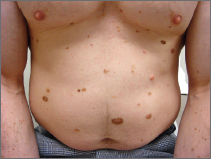An atypical nevus, also called a dysplastic nevus, atypical mole, or Clark's nevus, is a benign skin growth. In plain English, it means “unusual mole.”
However, it does share some features with melanoma and can look like a melanoma—but it's not a melanoma or a skin cancer.
Atypical nevus
An atypical nevus has some or all of the following features:
It usually has a flat appearance, but the center may be raised.
It has an irregular coloration (tan, brown, black, pink, or red).
Atypical nevus
What does it mean if I have only one or two of them?
If you have a few atypical nevi and no family history of many atypical nevi or melanoma, you probably have little risk of developing a melanoma and should not necessarily be identified as being melanoma prone.
Still, you should learn how to perform self-examination of your skin, and your health care provider should perform a skin examination and watch for any changes in your moles.
What does it mean if I have many of them?
The possibility that any particular atypical nevus developing into a melanoma cannot be determined exactly.
However, in some situations, atypical nevi are considered precursors to melanoma, as well as potential markers for someone who is at risk of developing melanoma. People are considered to have familial atypical mole syndrome (FAMS) if they meet the following three criteria:
A first-degree relative (e.g., parent, sibling, or child) or second-degree relative (e.g., grandparent, grandchild, aunt, uncle) with malignant melanoma
A large number of moles (nevi), often more than 50, some of which are atypical nevi
Moles that show certain features when examined under the microscope
The method chosen for treating a suspected atypical nevus depends on the purpose of removal.
If a melanoma is suspected, a complete excision (surgical removal) should be performed.
The wholesale removal of all atypical nevi is not generally considered a good idea.
What can be done to prevent the development of melanoma?
Anyone who has many atypical nevi should avoid excessive sun exposure and routinely use a sunscreen with a sun protection factor (SPF) of 30 or greater.
Those people who meet the criteria for FAMS should examine their own skin every 2 to 3 months, in addition to having a full-body examination and regular screenings performed by a dermatologist.
High-risk patients and their families should be taught self-examination to detect changes in existing moles and be given printed material with photographs to help them recognize the features of malignant melanoma.

